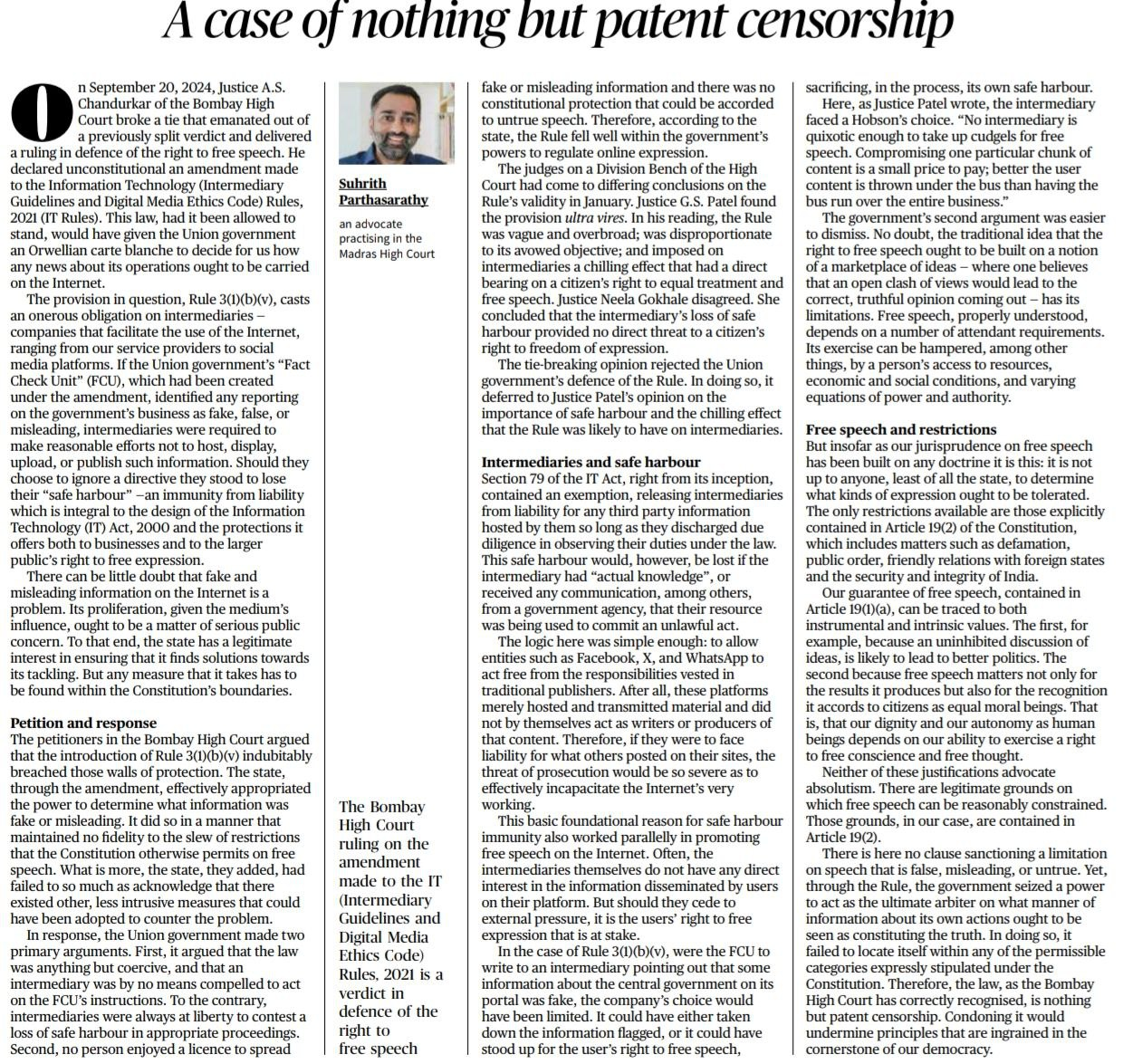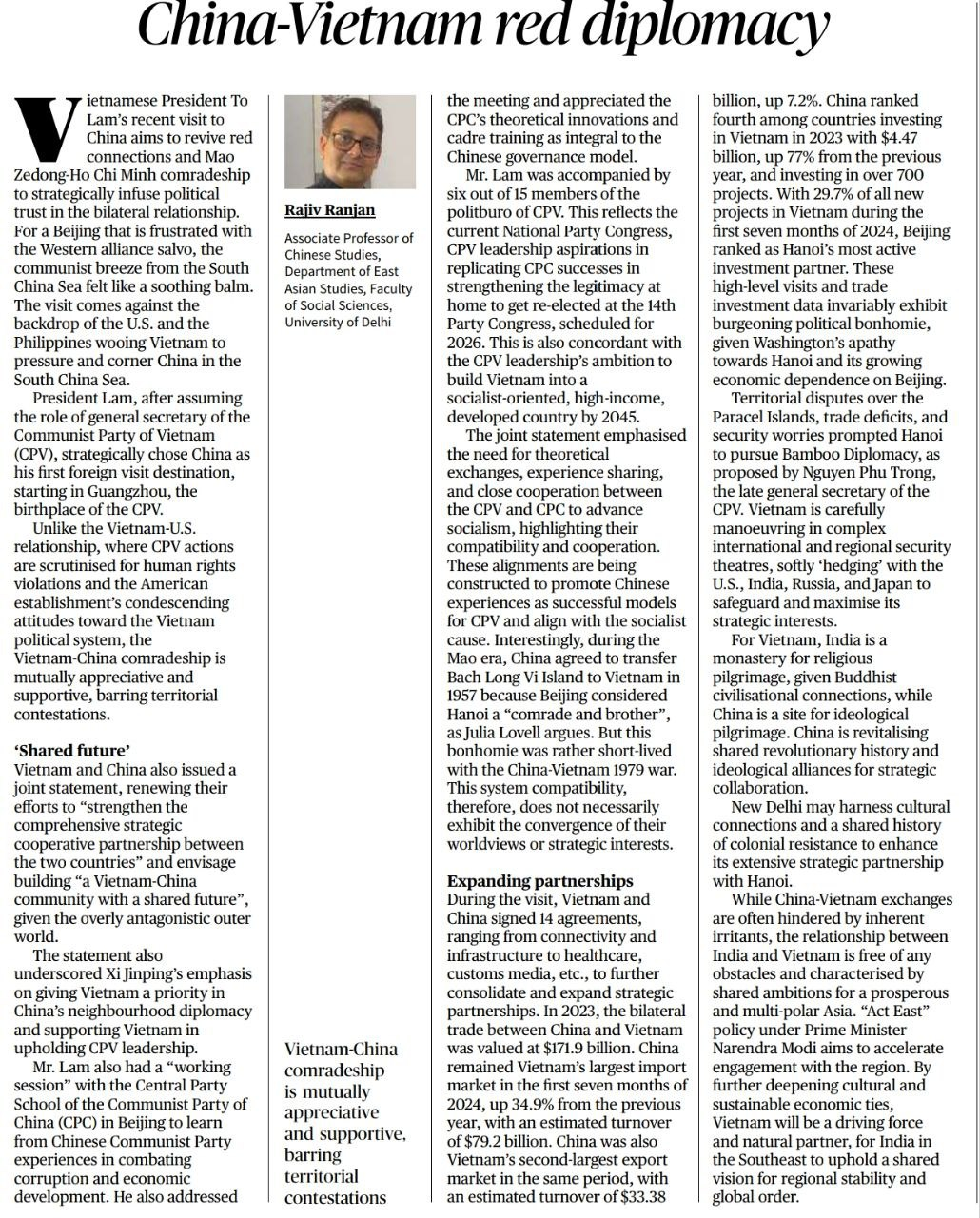1. Patent Censorship vs Free Speech: Analyzing the Bombay High Court's Ruling on IT Rules 2021
Introduction:
- The article discusses a recent ruling by Justice A.S. Chandurkar of the Bombay High Court, where an amendment to the Information Technology (Intermediary Guidelines and Digital Media Ethics Code) Rules, 2021, was deemed unconstitutional.
- The judgment centers on the right to free speech, intermediary liability, and government regulations on online content.
- The core issue relates to the Union government’s “Fact Check Unit” (FCU) and its powers over intermediaries (social media, service providers).
Key Points:
- Background of the Amendment:
- The amendment sought to give the government power to decide how any news related to its operations should be handled online.
- It imposed an obligation on intermediaries (internet service providers, social media platforms) to act on the FCU’s instructions, which could include taking down content deemed false or misleading.
- Intermediaries were required to take “reasonable efforts” to block or remove content or risk losing their “safe harbor” protection, which shields them from liability for third-party content.
- Court’s Reasoning:
- Justice Chandurkar declared that such provisions imposed an “Orwellian” carte blanche on government operations.
- He emphasized that intermediaries, under the amendment, would be unduly responsible for content, affecting their right to free expression.
- The court ruled that the amendment was a disproportionate measure to its avowed objectives, and overstepped the boundaries of the Constitution.
- Safe Harbor and Free Speech:
- The judgment focused on the “safe harbor” provisions, a crucial part of Section 79 of the Information Technology Act (IT Act), 2000.
- Safe harbor offers protection to intermediaries from liability, as long as they act as neutral platforms and have no active knowledge of the illegality of the content.
- The court upheld that intermediaries should not bear the burden of enforcing censorship unless they are clearly complicit in illegal activity.
- Importance of Free Speech:
- The decision highlighted the central role of free speech in a democratic society.
- The court underscored that any limitation on speech should be reasonable, rooted in necessity, and in line with Article 19(1)(a) of the Constitution.
- Restrictions on speech, such as defamation, national security, or morality, are already well-defined, and further restrictions should not be arbitrary.
- Rejection of Government’s Defense:
- The government had argued that the amendment was essential to prevent misinformation and protect public order.
- However, the court found that the provision placed an undue burden on intermediaries without providing sufficient checks on the government’s powers.
Conclusion:
- The ruling is a significant victory for free speech advocates and a major setback for government censorship efforts.
- It affirms the principle that the state cannot impose excessive and vague restrictions on intermediaries without violating constitutional protections.
- The judgment sets a precedent for balancing the right to free speech with the responsibilities of online platforms.
Mains Practice Question:
|
Q: The “safe harbor” principle plays a crucial role in protecting intermediaries from liability. Discuss its importance in the context of free speech, with reference to recent judicial decisions.
|
2. Vietnam-China Red Diplomacy: Balancing Ideological Unity and Territorial Tensions
Introduction:
- Vietnamese President To Lam’s recent visit to China aims to revive longstanding connections based on the shared historical context of Mao Zedong-Ho Chi Minh camaraderie.
- This diplomatic effort is set against a backdrop of the U.S. and the Philippines trying to strengthen ties with Vietnam in the South China Sea.
Key Points:
- Strategic Diplomatic Timing:
- The visit by President Lam is timely as the U.S. and the Philippines seek to woo Vietnam amidst territorial disputes in the South China Sea.
- The trip underscores the Communist Party of Vietnam’s (CPV) strategic reliance on China for foreign policy guidance, contrasting its tense relations with the U.S. over human rights concerns.
- “Shared Future” and Joint Statement:
- China and Vietnam issued a joint statement committing to strengthening their strategic cooperative partnership.
- They envision building a “Vietnam-China community with a shared future,” opposing antagonistic rhetoric from external powers like the U.S.
- President Xi Jinping reaffirmed China’s support for Vietnam’s diplomatic ambitions, offering insights into their shared worldview and mutual support.
- Vietnam Learning from Chinese Communist Party (CPC) Models:
- President Lam’s visit included meetings with CPC officials to learn from China’s experiences in curbing corruption and fostering economic development.
- Lam was joined by six members of the CPV politburo, signaling Vietnam’s intent to model CPC successes for its own governance.
- Economic and Trade Cooperation:
- China ranked fourth among foreign investors in Vietnam in 2023, showing a growing economic partnership.
- With 29.7% of all new projects in Vietnam being led by Chinese investments, Beijing continues to be Hanoi’s most active partner.
- Vietnam signed 14 agreements during the visit, ranging from healthcare and connectivity to trade, signaling its intent to further deepen this partnership.
- Territorial Concerns and Strategic Alignments:
- The article highlights historical and territorial frictions, such as China transferring Bach Long Vi island to Vietnam during the Mao era.
- Despite these territorial tensions, Hanoi continues to manage a balancing act with China, leveraging ideological compatibility to maintain relations.
- Vietnam-India Relations:
- The article emphasizes Vietnam’s close ties with India, rooted in shared cultural, historical, and religious connections.
- Vietnam sees India as a counterbalance to Chinese influence, especially under India’s Act East policy.
- This partnership, although free of ideological conflicts, faces challenges in expanding its scope due to China’s overwhelming presence in the region.
Conclusion:
- The visit signals Vietnam’s strategic alignment with China while carefully balancing its relations with other powers like India and the U.S.
- Vietnam-China camaraderie is marked by both cooperation and underlying tensions over territorial issues.
- Moving forward, Vietnam will continue to manage its foreign relations by leveraging its partnerships to ensure long-term stability and economic growth.
Mains Practice Question:
|
Q: Discuss the historical and strategic significance of Vietnam-China relations in the context of contemporary geopolitics. How do both nations navigate their shared ideological ties while managing territorial disputes?
|



